Ever been curious about the culinary tastes of milk snakes? You’re in for a treat! This article dives deep into the diet of these fascinating reptiles, particularly focusing on their penchant (or lack thereof) for frogs.
Yes, milk snakes do eat frogs. While frogs are a part of their varied diet, the frequency depends on the availability of frogs in their natural habitat. In areas where frogs are abundant, milk snakes might consume them more regularly. Their diet also includes rodents, birds, and other prey.
We’ve analyzed various factors influencing their dining choices, from their natural habitats and hunting techniques to potential threats they face from certain prey.
As we unravel the milk snake’s menu, you’ll discover a dynamic blend of adaptability, instinct, and evolution at play. Let’s embark on this gastronomic journey!
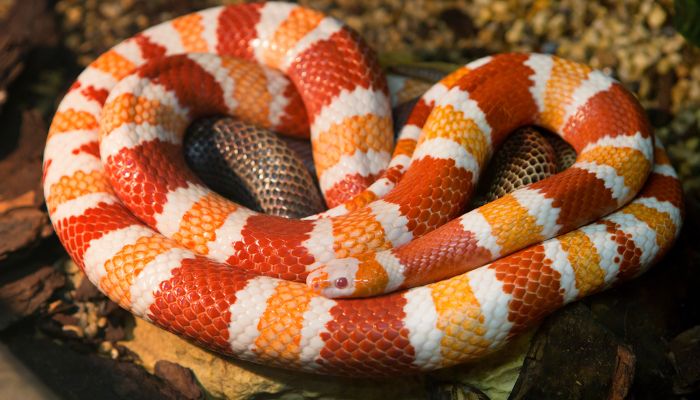
Table of Contents
- 1 The Milk Snake Diet: An All-You-Can-Eat Buffet
- 2 Reasons Why Milk Snakes Might Prefer Frogs
- 3 Milk Snakes and Their Frog-Hunting Techniques
- 4 Captive Milk Snakes: Does Diet Change in Captivity?
- 5 Potential Threats to Milk Snakes when Consuming Frogs
- 6 But Wait, There’s More on the Menu! Other Prey Items
- 7 Summary
- 8 FAQ
The Milk Snake Diet: An All-You-Can-Eat Buffet
If you’ve ever wondered about the diet of milk snakes, you’re in for a treat. And speaking of treats, let’s delve into the all-you-can-eat buffet that’s on a milk snake’s plate. Or, should I say, on its slithering path?
General overview of what milk snakes consume
First things first, milk snakes aren’t named for their beverage preference. In fact, their name originates from the myth that they suck milk from cows. Hilarious, right? But milk snakes, like other snakes, have a carnivorous diet.
- Mice and Rats: Small rodents are like the staple diet for many snake species, and milk snakes are no exception. They’re the go-to meal.
- Birds and Bird Eggs: Occasionally, they might climb trees or shrubs to snack on a bird or perhaps a juicy bird egg.
- Insects: Especially for the younger, tinier milk snakes, insects are a more manageable bite.
- Lizards: These reptiles are sometimes on the menu, especially in areas where both lizards and milk snakes thrive.
- Other Snakes: Surprising but true! Milk snakes have been known to indulge in a bit of cannibalism or dine on other snake species.
- Amphibians: Frogs, as we’ve discussed, and sometimes even salamanders, can be considered a treat.
- Fish: In areas near freshwater sources, milk snakes might occasionally snag a fish.
Importance of a varied diet for their health and wellbeing
The answer is more layered than you might think. You see, in the wild, diversity is the name of the game. Animals often consume a wide variety of prey to ensure they get all the nutrients they need. Milk snakes are no exception.
Having a varied diet not only guarantees they receive a balance of essential vitamins and minerals but also keeps them adaptable. An all-rodent diet? Boring! And certainly not representative of what they might find in their natural habitats.
Moreover, frogs?
They play a potential role in this gastronomic game. Frogs are loaded with moisture and are an excellent source of hydration, especially for snakes residing in drier climates.
But do they specifically hunt for frogs, or are frogs just a serendipitous snack?
What types of frogs (if any) they are more inclined to eat
While milk snakes don’t specialize in frog consumption, they certainly wouldn’t turn their noses up (or should we say, tongues out?) at one.
Depending on their size, milk snakes might opt for smaller frog species if they come across them. However, larger, more toxic frogs might be off the menu due to potential risks.
In areas where frogs are more abundant, such as wetlands, milk snakes might have a higher chance of including them in their diet. It’s all about opportunity. Think about it like us stumbling upon a surprise dessert table at a buffet.
Sure, it wasn’t the plan, but hey, who can resist?
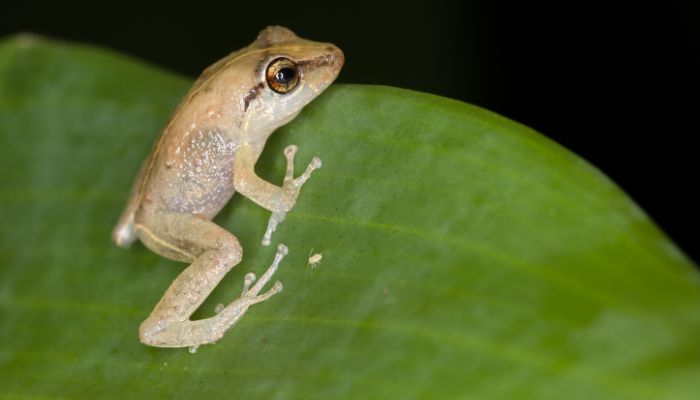
Reasons Why Milk Snakes Might Prefer Frogs
Frog availability in the snake’s natural habitats
Just like us humans heading to a local eatery, milk snakes are all about convenience. The geographical spread of milk snakes encompasses regions where frogs are, quite literally, jumping about.
These habitats, rich in biodiversity, present an opportunity for milk snakes to have frogs on their dining list. If it’s available and on the path, why not?
Nutritional benefits of consuming frogs
Beyond just being a potential snack, frogs serve up some serious nutritional punch. They’re loaded with proteins and essential amino acids. Moreover, as mentioned earlier, they’re a hydration powerhouse.
For a creature that doesn’t always have direct access to water sources, a juicy frog can be a lifesaver.
Ease of catching and consuming frogs
Here’s the thing: frogs might be jumpers, but against a stealthy milk snake, they often don’t stand a chance. Without the speed of rodents or the flight capabilities of birds, frogs become an easier target, making them a tempting treat.
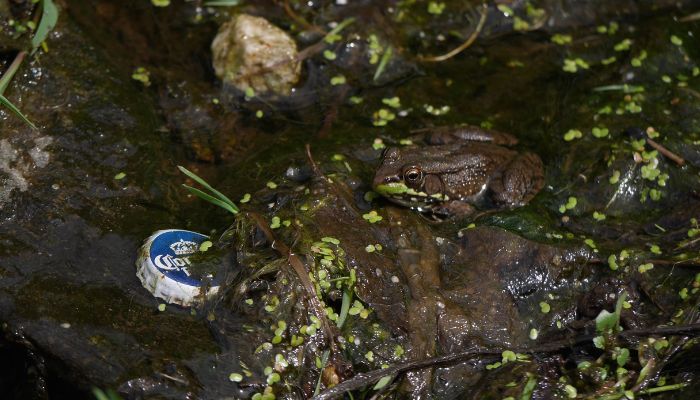
Milk Snakes and Their Frog-Hunting Techniques
How do they track and locate frogs?
Milk snakes have an arsenal of senses. Their forked tongues, constantly flicking, pick up scent particles from the air. This tongue-tastic technique can lead them straight to a potential froggy meal.
Their keen sense of vibration also helps them detect any movements of nearby prey, including the subtle hops of frogs.
The actual act of capturing and consuming a frog
Once a milk snake has its eyes (and senses) set on a frog, it’s game time. Using its stealth and speed, the snake will make a sudden strike, grabbing the frog.
It’s a swift process, with the snake ensuring it has a firm grip before beginning the act of swallowing. Frogs, unlike some prey, don’t require constriction. Once captured, it’s straight to the swallowing part.
Any unique adaptations for frog hunting?
While milk snakes don’t have specific adaptations solely for frog hunting, their general predatory adaptations serve them well.
Their flexible jaws, for instance, allow them to swallow prey larger than their heads, making it relatively easy to gobble down frogs. Additionally, their keen senses, combined with their camouflaging colors, make them adept at ambushing unsuspecting frogs.
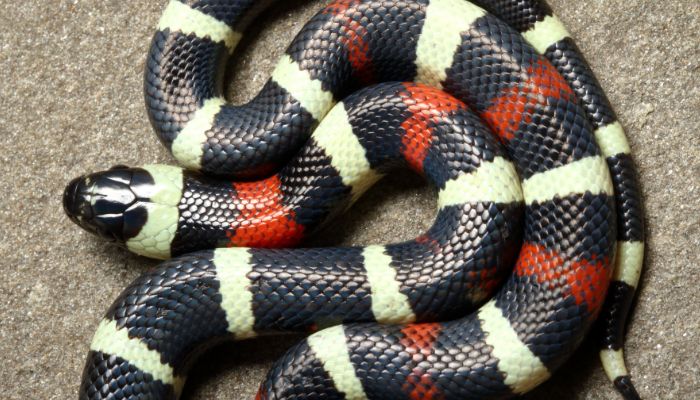
Captive Milk Snakes: Does Diet Change in Captivity?
The general diet of captive milk snakes
When milk snakes find themselves in the cozy enclosures of homes as pets, their diet often sees a slight shift. No more hunting in the wild, these captives are usually served a diet that’s convenient for their caregivers.
Commonly, this means a consistent offering of mice or other small rodents, which can be easily purchased frozen (and then thawed) from pet stores.
Are frogs more or less common in a controlled environment?
In a controlled environment, the introduction of frogs into a milk snake’s diet is rarer. For one, sourcing frogs regularly can be challenging.
Additionally, feeding captive snakes wild-caught frogs might introduce potential pathogens or toxins, which could be harmful. Hence, for simplicity and safety, many snake keepers stick to a rodent-based diet.
Any considerations for those who keep milk snakes as pets
For those lucky humans sharing their space with a milk snake, it’s crucial to ensure a balanced diet that mimics what the snake would consume in the wild. While rodents are the primary staple, variety is essential.
Introducing occasional variations like chicks or quail eggs can be beneficial. However, always source from reputable suppliers and avoid wild-caught prey to minimize disease risks.
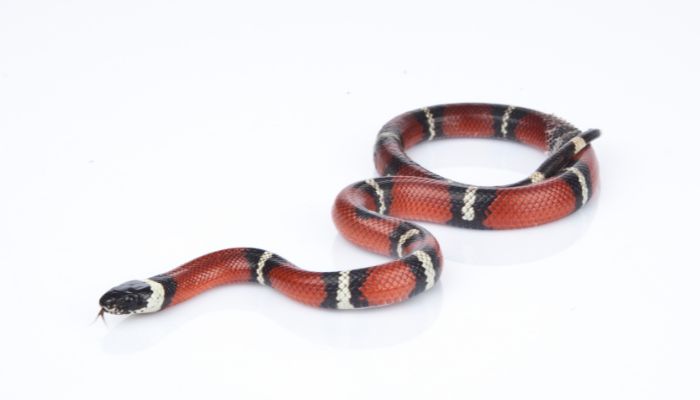
Potential Threats to Milk Snakes when Consuming Frogs
Toxins and dangers from certain frog species
Nature has its way of balancing things out. While frogs serve as prey to many, they aren’t defenseless. Some frog species excrete toxins that can be harmful, or even fatal, to predators.
These toxins can cause irritations, paralysis, or worse when ingested.
How milk snakes handle or avoid these threats
Milk snakes, over time, have developed keen senses and instincts. While they might occasionally fall victim to a toxic frog, many have learned to identify and avoid the more poisonous varieties.
Evolution has played a role, and those who’ve consumed harmful frogs in the past probably didn’t live to tell the tale (or reproduce). Thus, the more cautious and discerning milk snakes have passed down their genes.
Importance of knowing which frogs are safe to eat
For a milk snake, the stakes are high. Making a meal out of the wrong frog can be the last mistake they make.
This is why, over generations, they’ve developed an innate sense of which frogs might be a risky meal. While not foolproof, this selective feeding ensures the survival of the species, proving once again that in nature, it’s always a dance of survival, risks, and rewards.

But Wait, There’s More on the Menu! Other Prey Items
Milk snakes aren’t just about frogs and rodents. These guys are true food enthusiasts, and their menu extends beyond the usual. Let’s take a delightful journey into the world of milk snake gastronomy, shall we?
List of other common prey for milk snakes
Birds: When a milk snake is feeling a bit adventurous, it might take to the trees in pursuit of some feathery prey. Birds provide a good source of protein, and their diverse diet can offer additional nutrients to the snake.
Bird Eggs: Think of these as nature’s little protein packets. Bird eggs are nutritious, easy to swallow, and don’t put up a fight. It’s like the fast food of the wild!
Lizards: Being cold-blooded kin doesn’t give lizards a free pass. Lizards are often the right size for milk snakes, and their slower movement (compared to, say, a darting mouse) can make them an attractive option.
Other Snakes: It might sound like something out of a movie, but some milk snakes have been observed feasting on smaller snakes, including their own kind. It’s a snake-eat-snake world out there!
Insects: Especially favored by younger snakes, insects are the equivalent of a beginner’s level in the snake diet game. They’re more accessible to catch and provide the necessary nutrients for growing snakes.
Fish: While not their primary choice, if a milk snake finds itself near water and spots an unsuspecting fish, it might just take the opportunity for some sushi, so to speak.
Why other prey items might be good for the snake
Each of these prey items brings something unique to the table. Birds and their eggs offer protein and other nutrients from the diverse avian diet. Lizards, other snakes, and fish provide hydration and essential amino acids.
Insects, while smaller in size, can be rich in fats and other nutrients, essential for younger snakes’ rapid growth.
Any specific prey that might be a favorite?
While it’s hard to pinpoint a universal favorite (as individual snake preferences can vary), many herpetologists believe that rodents, given their availability and size, might top the list for adult milk snakes.
It’s like their version of a comfort food. However, in areas where frogs are abundant, they might lean more towards an amphibian-rich diet. It’s all about what’s on the local menu!
Summary
You’ve journeyed through the captivating world of milk snakes and their diverse diet, discovering that frogs are indeed on their menu.
Alongside frogs, these snakes have a buffet of choices from birds to even other snakes! Remember, the natural world is full of intriguing relationships and dietary habits.
As you continue to explore, let your newfound knowledge of milk snakes be a testament to the wonders that await. Keep that curiosity alive, and you’ll always find more amazing insights waiting for you!
FAQ
What do milk snakes eat?
Milk snakes are versatile eaters! Their diet mainly consists of mice, rats, birds, bird eggs, lizards, other snakes, insects, and occasionally, fish. Frogs are also on their menu, especially in areas where these amphibians are abundant.
Do milk snakes need water?
Absolutely! Just like all living beings, milk snakes need water to stay hydrated. They usually drink from ponds, puddles, or dew. In captivity, it’s essential to provide them with a fresh water dish.
Are frogs afraid of snakes?
While “afraid” might be anthropomorphizing a bit, frogs do recognize snakes, including milk snakes, as predators. They will typically respond with evasion tactics, like jumping away or hiding, to avoid becoming a meal.

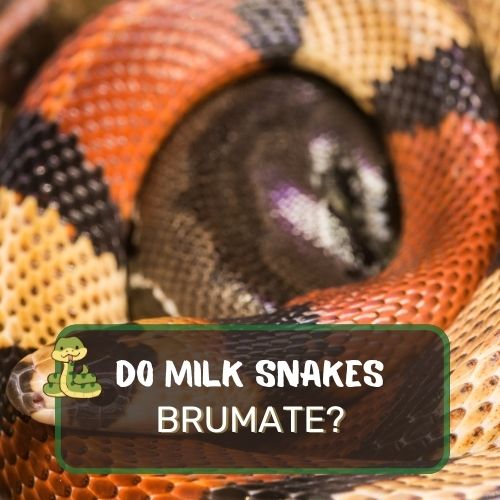
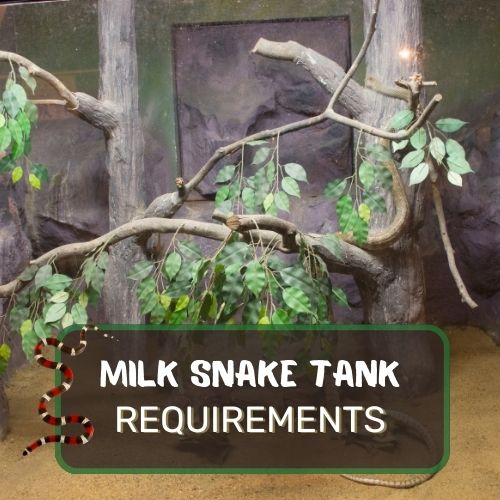
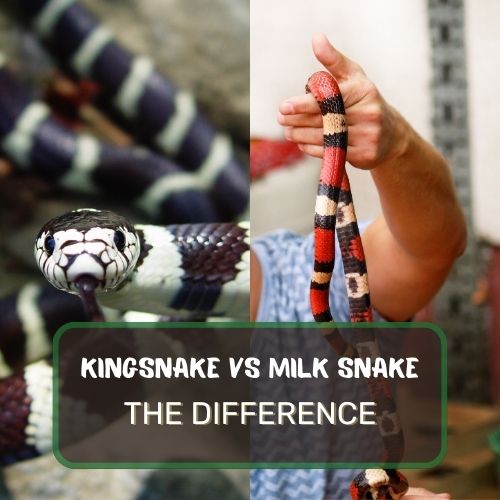
0 Comments